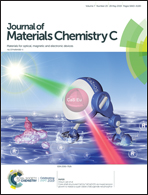Cationic compositional effects on the bias-stress stabilities of thin film transistors using In–Ga–Zn–O channels prepared by atomic layer deposition
Abstract
Cationic compositional effects of amorphous In–Ga–Zn–O (a-IGZO) prepared by atomic layer deposition (ALD) were strategically investigated for thin film transistor applications. The atomic compositions (In : Ga : Zn) of ALD-IGZO films were varied to 1 : 1 : 1, 1 : 1 : 3, and 1 : 1 : 5 by controlling the ALD cyclic ratios. The relative content of oxygen vacancies and temperature-dependent electrical conductivities among the films markedly varied with the In/Zn ratio. The device employing the 1 : 1 : 5 composition exhibited inferior characteristics owing to the excessive Zn content in the IGZO channel. With increasing In/Zn ratio, the density of subgap states near both the conduction and valence bands increased, resulting in a higher degree of bias-stress instability. The device employing the 1 : 1 : 3 composition exhibited the most promising device characteristics including excellent stabilities under positive bias-stress at 60 °C and a negative bias-illumination-stress condition using a green wavelength, in which the threshold voltage shifts were estimated to be as low as +0.8 and −1.5 V, respectively.



 Please wait while we load your content...
Please wait while we load your content...